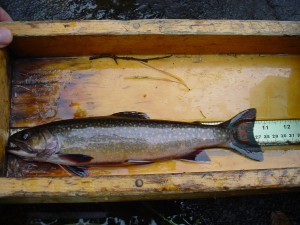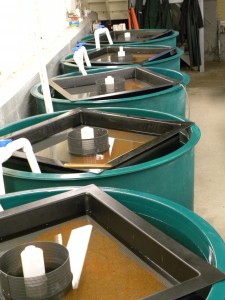September 20, 2012 at 5:43 pm
Fall is just around the corner and IFW’s wildlife and fisheries biologists and hatchery personnel are rushing around preparing for the coming cool weather and all of the hunting, fishing, and fish stocking that come with it!
For wildlife biologists, this means monitoring the black bear harvest, which is currently in full swing, and preparing themselves and the many tagging stations statewide for the inevitable rush of moose and deer and turkeys that will be coming in! This may not sound like much, but a mound of biological data is collected from harvested animals each fall to give biologists an idea of the healthy of our game populations. For each black bear and moose harvested, a tooth is pulled to age the animal and general coat and body condition is noted. For moose and deer, antler beam diameter and antler spread is measured, the number of points are counted, and in some cases brain stem samples are taken to test for Chronic Wasting Disease. Also for moose, winter tick monitoring occurs in October and reproductive collections are taken from November hunt cows. For turkeys, spur lengths and beard lengths are collected.
[caption id="attachment_410" align="alignright" width="300"] A biologist measures a male brook trout on a measuring board.[/caption]
For fisheries biologists, fall spawning runs are headed off with trap nets. This is a non-lethal method of collecting fish as they head up the rivers, streams, and brooks to spawn. Biological measurements such as lengths and weights, and even sometimes scales for aging, are all taken. Overall condition of the fish are noted and they are released to continue to go about their business. In some bodies of water, some of these fish are ‘stripped’. This means that biologists and hatchery personnel collect eggs and milt (fish sperm) from the desired fish to use in our hatcheries. These are collected from various age-classes of fish in certain areas to keep genetic diversity in our hatchery raised fish that are stocked in the spring and the fall.
Hatcheries are stocking fish across the state and, as mentioned above, working on collecting the next batch of eggs and milt that they will grow into the tens of thousands of fish that will be stocked over the next two years. This might sound like an easy, laid back job; it isn’t. Raising so many fish to be healthy, strong fighters once on the line is a difficult task requiring skill, knowledge, and a whole lot of patience and attentiveness. Maine is very lucky and proud to have the renowned hatchery and fish stocking programs we have.
[caption id="attachment_411" align="alignleft" width="225"]
A biologist measures a male brook trout on a measuring board.[/caption]
For fisheries biologists, fall spawning runs are headed off with trap nets. This is a non-lethal method of collecting fish as they head up the rivers, streams, and brooks to spawn. Biological measurements such as lengths and weights, and even sometimes scales for aging, are all taken. Overall condition of the fish are noted and they are released to continue to go about their business. In some bodies of water, some of these fish are ‘stripped’. This means that biologists and hatchery personnel collect eggs and milt (fish sperm) from the desired fish to use in our hatcheries. These are collected from various age-classes of fish in certain areas to keep genetic diversity in our hatchery raised fish that are stocked in the spring and the fall.
Hatcheries are stocking fish across the state and, as mentioned above, working on collecting the next batch of eggs and milt that they will grow into the tens of thousands of fish that will be stocked over the next two years. This might sound like an easy, laid back job; it isn’t. Raising so many fish to be healthy, strong fighters once on the line is a difficult task requiring skill, knowledge, and a whole lot of patience and attentiveness. Maine is very lucky and proud to have the renowned hatchery and fish stocking programs we have.
[caption id="attachment_411" align="alignleft" width="225"] Brook trout eggs incubate on trays in a hatchery.[/caption]
There’s a lot to enjoy regarding fish and wildlife in Maine in the fall. Stay tuned to find out more!
Brook trout eggs incubate on trays in a hatchery.[/caption]
There’s a lot to enjoy regarding fish and wildlife in Maine in the fall. Stay tuned to find out more!
 A biologist measures a male brook trout on a measuring board.[/caption]
For fisheries biologists, fall spawning runs are headed off with trap nets. This is a non-lethal method of collecting fish as they head up the rivers, streams, and brooks to spawn. Biological measurements such as lengths and weights, and even sometimes scales for aging, are all taken. Overall condition of the fish are noted and they are released to continue to go about their business. In some bodies of water, some of these fish are ‘stripped’. This means that biologists and hatchery personnel collect eggs and milt (fish sperm) from the desired fish to use in our hatcheries. These are collected from various age-classes of fish in certain areas to keep genetic diversity in our hatchery raised fish that are stocked in the spring and the fall.
Hatcheries are stocking fish across the state and, as mentioned above, working on collecting the next batch of eggs and milt that they will grow into the tens of thousands of fish that will be stocked over the next two years. This might sound like an easy, laid back job; it isn’t. Raising so many fish to be healthy, strong fighters once on the line is a difficult task requiring skill, knowledge, and a whole lot of patience and attentiveness. Maine is very lucky and proud to have the renowned hatchery and fish stocking programs we have.
[caption id="attachment_411" align="alignleft" width="225"]
A biologist measures a male brook trout on a measuring board.[/caption]
For fisheries biologists, fall spawning runs are headed off with trap nets. This is a non-lethal method of collecting fish as they head up the rivers, streams, and brooks to spawn. Biological measurements such as lengths and weights, and even sometimes scales for aging, are all taken. Overall condition of the fish are noted and they are released to continue to go about their business. In some bodies of water, some of these fish are ‘stripped’. This means that biologists and hatchery personnel collect eggs and milt (fish sperm) from the desired fish to use in our hatcheries. These are collected from various age-classes of fish in certain areas to keep genetic diversity in our hatchery raised fish that are stocked in the spring and the fall.
Hatcheries are stocking fish across the state and, as mentioned above, working on collecting the next batch of eggs and milt that they will grow into the tens of thousands of fish that will be stocked over the next two years. This might sound like an easy, laid back job; it isn’t. Raising so many fish to be healthy, strong fighters once on the line is a difficult task requiring skill, knowledge, and a whole lot of patience and attentiveness. Maine is very lucky and proud to have the renowned hatchery and fish stocking programs we have.
[caption id="attachment_411" align="alignleft" width="225"] Brook trout eggs incubate on trays in a hatchery.[/caption]
There’s a lot to enjoy regarding fish and wildlife in Maine in the fall. Stay tuned to find out more!
Brook trout eggs incubate on trays in a hatchery.[/caption]
There’s a lot to enjoy regarding fish and wildlife in Maine in the fall. Stay tuned to find out more!